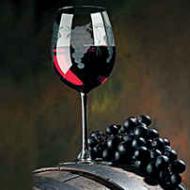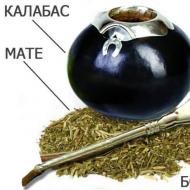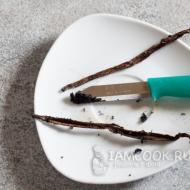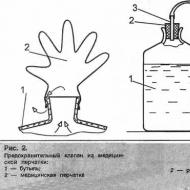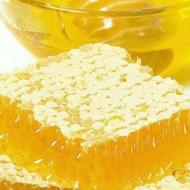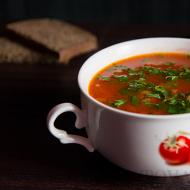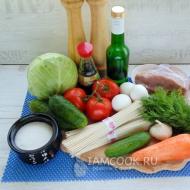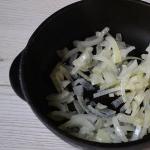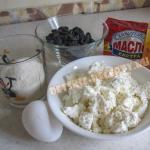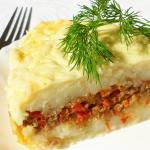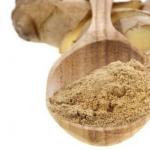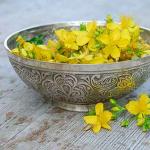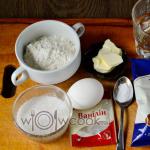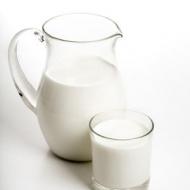
Homemade wine from grapes with a glove - a way out! Technology for making homemade wine from grapes with a glove. The simplest recipe for making homemade wine Homemade grape wine
Grapes are suitable for preparing various drinks. From it you can make a lot of very tasty drinks, including fortified wines. In this article, we want to tell you about some easy grape wine recipes at home. The cooking method is described step by step.
Navigation
Grape varieties for home wine
The quality of the wine is influenced by the grapes used. It is better to select technical varieties suitable for making wine drinks, because they contain a lot of juice, which turns into wine during fermentation.
The best grapes used for making wine are table grapes. In most cases, its clusters do not differ in special size, and the berries are small. Muscat varieties are the best choice for preparing drinks at home, due to their pleasant aroma and taste.
Homemade grape juice wine
Making wine from grape juice at home is pretty easy.
Required Ingredients:
- Nine liters of grape juice;
- 2.5 kilograms of sugar.
Cooking:
- First you need to get juice. To do this, sweet grapes need to be thoroughly mashed and squeezed. The collected juice is useful to prepare the wort, and the remainder is suitable for creating excellent moonshine.
- In a container, which can be a barrel or a jar, drain the juice and cover it with gauze, and then put it in a warm place for 5 days.
- During this period, stir the juice a couple of times a day, and when the pulp pops up, throw it in a colander and squeeze it well through cheesecloth.
- Juice must be poured into glass jars. Pour sugar into it and stir.
- Rubber gloves should be pulled over the throats of all cans, which should be pierced with a needle in some places. The benefit of this is to allow air to escape during fermentation.
Store the wort at room temperature for five weeks. If the gloves on the jars are blown off, then the wine can be poured into bottles and stored in a cool place.
Homemade wine from dry grapes
Wine made from dry grapes is an excellent dessert drink, the most “correct” wine for treating guests.
Required Ingredients:
- Seven liters of water;
- Two kilograms of sugar;
- One kilogram of dry grapes.
For sourdough:
- Two tablespoons of sugar;
- One glass of water;
- One glass of raisins.
Before you start cooking grape wine, you need to prepare a sourdough.
- Grind the raisins, add a little sugar, mix well and pour warm water.
- After this, the sourdough must be kept warm for several days. When it is well sour, start cooking the wort.
- From the grapes it is required to cut off the branches, then pour sugar into it and stir well in order to achieve a uniform mass.
- Add warm water, mix well again and pour over the starter.
- After completing all the previous steps, close the container with a lid with a water seal and keep it warm. In the absence of such a lid or the non-standard neck of the jar, put on a rubber glove with several small holes made in it in advance.
After a while, the mixture should ferment well.
How long does the fermentation process take? Most often it lasts about a month. After the bubbles disappear and the glove falls off, the drink must be drained from the sediment. Then pour it into bottles and keep it cool for two to three months.
Homemade wine from green grapes
Wine from green grapes is characterized by excellent appearance and excellent taste. You need the following components:
- One bucket of grapes (for five liters of juice);
- 2.5 kilograms of sugar.
Cooking:
- Before you start cooking grape wine, you need to carefully sort out the berries and discard the spoiled components.
- Having done this, the grapes must be crushed with a wooden pusher, then placed in a barrel or pan made of enamel, and covered with a piece of gauze or a linen towel.
- The wort should be kept warm and stirred at least a couple of times a day.
- After three days, it is required to strain the mixture, and remove the surfaced pulp and squeeze it well.
- Then we add sugar to the workpiece, stir, after which the resulting mixture is poured into two-three-liter glass jars. We lock them with lids with a water seal or put on rubber gloves.
We transfer the mixture into the room, the temperature in which is fifteen to eighteen degrees, and keep it there for at least two months. At the end of fermentation, pour the drink into bottles or jars. We store them in a cool place for two months so that the drink can ripen.
You can use frozen grapes to make wine, but then be sure to add wine yeast, otherwise the wine will not ferment
Homemade wine from Isabella grapes
This drink made from black berries has a very pleasant taste. Its preparation is described below.
- Clean the grapes thoroughly and squeeze the juice out of them.
- Put the pulp on the bottom of the pan and top up with water from above in a volume equal to a third of the volume of crushed grapes with black berries.
- Then sprinkle the mixture sugar in the amount of 45 g/l.
- Stir it and keep warm for a number of days.
- Remove and squeeze out the pulp when the mixture begins to ferment.
- Pour the wort into bottles 3/4, and securely close the necks with caps.
- Store it at room temperature for a couple of days, and then put rubber gloves or water-tight lids on the bottles.
After fermentation stops, strain the drink several times and pour into bottles or jars. Then keep it cool for a while (recommended for several months. This will improve the taste of the drink).
Homemade raisin wine
Required Ingredients:
- 1.2 kilograms of raisins;
- Three hundred grams of sugar;
- 2.5 liters of water.
Recipe:
- Sort, rinse and place the raisins in a five-liter jar.
- Dissolve sugar in warm water and pour into raisins.
- During fermentation (two weeks), the container will need to be shaken from time to time.
- The resulting mixture should be poured into a separate bottle, and the raisins that remained in the jar should be mashed.
- Pour in the drained liquid and add water on top.
- Cover the container and wait for the completion of fermentation, which will last thirty to forty days. It is worth noting that during this process the water in the keg will evaporate, so top it up occasionally.
- Remove the young wine from the sediment and let it stand for two to three months. Then re-drain the drink, pour it into bottles and cork.
A bottle of grape wine prepared with love can be not only a great addition to a festive feast, but also a memorable tasty gift. In the world there are a huge number of grape varieties of different ripening periods and for different purposes: depending on the taste of the berries, the recipe and the technology of preparation, as a result, you can get a large number of natural and healthy drinks.
Let's make sure: making wine on your own is a very exciting process and not as complicated as it might seem. Making wine according to a simple recipe is suitable not only for novice winemakers, but also for experienced happy owners of home vineyards.
To prevent the drink from turning into vinegar, you need to follow simple recommendations.
So, you will need:
- grapes - 10 kg.,
- 2.5 or 3 kg - sugar.
Put ripe bunches of grapes in an enamel bowl of a suitable size (bucket, large bowl) and carefully crush with your hands (you can use an ordinary pusher) until the berries release the juice. Then cover the container with gauze and just leave it in a warm room for fermentation for 5 days. Stir the resulting mass twice a day. After the pulp (waste from crushed berries) rises to the top, you should discard it with a colander and pass the juice through cheesecloth.
- Only unwashed berries with a white, natural coating are suitable for making wine. Otherwise, the fermentation process will not occur.
- Do not use metal utensils to prepare the drink: it will oxidize and lose its taste.
Pour the strained juice into jars, add sugar and mix well. Put a medical glove on the neck of the jar and tie it with an elastic band in a circle. On the fingers of the glove, you need to pierce several holes with a needle. So at room temperature, the wine should stand for 2-3 weeks. The fact that the fermentation process continues can be understood by the glove: initially it inflates, and at the end it should deflate. When the wine becomes transparent and a yeast sediment forms on the bottom of the container, carefully pour the drink into clean bottles and, tightly closing the lids, place in a cool place. For some time (about a month), a natural sediment may appear at the bottom of the bottles, which must be drained and poured into a clean container. When it stops forming, we can assume that the young wine is ready.
Homemade red wine from blue grapes (sweet, semi-sweet)

If blue grapes grow in abundance in your garden, then you can make your own sweet or semi-sweet wine according to the above recipe.
At the same time, it is necessary to take into account that for the preparation of semi-sweet wine of sugar, you need to add 1 kilogram per 10 liters of must, and sweet 3-3.5 kg for the same amount of juice.
Dry white wine - "with your own hands"

Therefore, we will discuss only the most important points:
- To obtain white wine, you should choose grape varieties with a sugar content of at least 15%.
- The higher the sugar content of the grapes used, the higher the final strength of the drink will be.
- You need to pick berries only in dry weather, you can not wash them. You can wipe them with a clean dry cloth.
- White wine can ferment up to 25 days. How to determine the readiness of the mash? - The readiness of the mash can be determined by the precipitation of the corresponding sediment and the cessation of the formation of bubbles in it (the last couple of days).
- White young wine can be tasted after decanting and bottling, but for the full disclosure of taste qualities, an aging period of 30-40 days is desirable.
Brand (grade) "Isabella" at home
You can also make wine at home from the Isabella grape variety. It is enough to have all the necessary ingredients and then proceed according to the recipe.

First of all, the juice is squeezed out of the selected berries. Then - the resulting crushed mixture of berries is placed in a container and water is added from above: its amount should be one third of the volume of the crushed berries. Pour sugar on top at the rate of 40 grams per liter, mix everything thoroughly. The container must be hidden for several days in a warm (not hot) place. The pulp that floats to the surface indicates the ongoing fermentation process. It is removed by carefully squeezing through cheesecloth. After that, the wort is poured into clean bottles or jars to three-quarters of their volume and tightly corked, leaving at room temperature. After 3 days, you can put rubber gloves on the jars and wait for the fermentation process to complete.
The resulting wine is again filtered and bottled. If sediment appears at the bottom of the bottle, then the alcoholic drink must be filtered. Ready young wine is stored in a cool place.
Recipe for a simple homemade wine made from grapes with the addition of water and sugar
To make white wine we need:
- ripe green grapes of sweet varieties;
- sugar (based on 200g per liter of juice);
- water (add as desired, but not more than 1/3 of the volume of the berries).
All actions are performed, as in the above recipes, only water is added if desired. Pure water should be poured in during the pre-fermentation process (when the pulp has not yet been removed and the drink has not been filtered).
How to make wine with a stretched glove?
Earlier we described the process of making wine, where it was recommended to put on a rubber glove on the container. This is done not only to monitor the fermentation process, but also to remove carbon dioxide, which is important for the quality of the future drink. It is to remove air from the container that several punctures are made on the glove. The most suitable for winemaking is the usual thin medical glove.
Wine from grapes does not play, what should I do?

If you put the wine in a room where it is too hot, and it has stood there for several days, then to restore the fermentation process, add a handful of unwashed crushed berries to it (you can use 25 grams of raisins per 5 liters of mash).
If the wine is bitter

If, nevertheless, after tasting, you find that the drink is bitter, then you can try to remove it with whipped protein. To do this, the egg white is separated from the yolk and whipped into foam, a little wine is added, beaten again and poured into the rest of the drink in a thin stream. The wine is left to settle: a sediment should form at the bottom of the container.
It is important to remember that the protein of one egg is enough to clean 50 liters of wine from excessive astringency.
How to add degrees to homemade wine?

Making wine is a "capricious" process requiring attention and certain knowledge. Despite this, by strictly following the recipe and recommendations, in the end you will be able to create a wonderful homemade product that you will be proud of.
At home, you can choose absolutely any sort this plant. Moreover, a sunny drink can be made from a combination of various. Even if you mix blue varieties, the wine will not decrease in taste from this, and in some cases it will add.
Most often, a grape drink is prepared from the following: "Friendship", "Crystal", "Stepnyak", "Platovsky", "Festival", "Saperavi", "Rosinka". All of the above contain a large amount of sugar in their berries, so the drink is especially tasty.
Did you know?In 2000, at a wine auction, a 6 liter solar drink was sold for half a million dollars. It was a 1992 vintage, and it was bought by American top manager Chase Bailey.
The most common "wine" consider: "Pinot Blanc" or "Pinot Noir", "Aligote", "Sauvignon", "Merlot", "Cabernet".
Fruit drinks have a special taste. They are famous for their rich texture and unique taste. But delicious wine can be made from even the most common wild blue.

Grape preparation
Raw materials for making solar drink should be collect in September, and in the southern regions - in October. Harvesting is best done in clear and sunny weather, it is desirable that there are no cold and rainy days 2-3 days before picking the berries. After collecting it, you need to sort it out: discard all unripe, dry and green berries, remove excess and leaves.
After picking the berries, they need to be laid out for several hours in the sun. This will give the grapes a more intense flavor. It is not for nothing that winemakers say that wine is a living product that feels any manipulation on it. But you should not store the collected bunches for more than two days.
The resulting pulp and juice should be covered with a cloth and put in a dark, warm place for 3-4 days. After a while, the pulp will float to the surface, the juice will be easier to separate. And do not forget to stir the container with the mixture at least twice a day, otherwise the juice may turn sour.
Getting Pure Juice
Did you know?The Palatinate Museum houses the world's oldest bottle of wine. It dates back to 325 AD.
Wine maturation
After all the above processes, the wine can be left to mature. Sunny drinks from white varieties should be aged for a month and a half, and from red varieties - two. Aged more than a year for none of the wines no need, it will not make any sense (such actions will not affect the organoleptic properties of the drink).
A young drink is best poured into glass containers of not very large sizes. You need to fill it with wine to the very brim so that there is no room for air in the container. It is best to cork containers with cork plugs. You need to store a sunny drink in a cool dark place at a temperature of 5-20ºС.
Purification of wine from impurities
Clarification of wine at home can be carried out various methods. We will tell you more about the main ways to clean a solar drink:
- Cleansing with gelatin. To clarify the wine in this way, you need to take 10-15 g of gelatin per 100 liters of drink. For 24 hours, gelatin should be soaked in cool water, changing it three times during this time. Gelatin should be diluted in warm water and add the resulting mixture to a container with a drink. After 2-3 weeks, all excess substances will “stick” to the gelatin and precipitate. You just need to collect it, and the wine will become much lighter.
- Heat treatment. All glass bottles of wine should be placed in an iron bowl or pan, filled with water to the very top of the bottles and put on fire to heat. At the same time, the bottles must be tightly corked so that the alcohol from the solar drink does not evaporate. Heat the water in the container to 50-60 °. Repeat the procedure 2-3 times. After a few days, the wine will have a sediment. It can be removed in the way that we described above.
- Activated carbon. Clarification in this way is used in extreme cases. For example, when the wine has an unpleasant smell. It is necessary to use not pharmacy coal, but
Homemade grape wine has always enjoyed considerable popularity at any table, so every winemaker, even a beginner, is happy to try to create wines according to various recipes, including the classic version - from grapes.
Your attention is the recipe for excellent grape wine: step by step and simply at home (with photos and instructions).
Choosing the right vintage for your wine
In order for grape wine (and not only homemade) to turn out really tasty and fragrant, it is necessary to use exclusively high-quality and, most importantly, the right product for its creation - wine varieties.
The berries of these varieties are small in size and dense in clusters. Below are some valuable tips from experienced winemakers regarding the selection and preparation of material for wine:

Advice. Grapes harvested for making wine should not be washed, because the white coating that forms on it is nothing more than wine yeast. Rinsing or even washing grapes is possible only if a sourdough with high-quality wine yeast is used.
Harvested grapes should be separated from the ridges, sorted out, removing all unsuitable, including dried and moldy berries. After preliminary selection, the berries are poured in small batches into a deep container and crushed. You can use a regular potato crusher or meat grinder. The berries should be crushed very carefully so that each of them gives all its juice.
The process of making wine
Creating a quality wine is a fairly simple process if you strictly follow all the steps of the recipe. The following is a step-by-step process for making wine.
Pulp fermentation
The finished pulp or crushed berries, previously separated from the ridges, are poured into a suitable container and tightly covered with a cotton cloth. Keep in mind that the container should be filled with wine material only 2/3.
The pulp container is installed in a room with a strict temperature regime, falling in the range from 18 to 23 degrees. If the temperature is above the second mark, the fermentation of the pulp may be too intense, which will turn it into vinegar as a result. If the temperature is below the first mark, the fermentation process may proceed too slowly or even not start at all.

So, after a few days, the fermentation process will begin and the must will begin to separate from the pulp (juice, which is, in fact, young grape wine). The pulp and wort should be thoroughly mixed every day, otherwise the first one will simply turn sour and the taste of the unfinished product will be spoiled.
Grape must preparation
After 5-7 days after the start of fermentation, the pulp should be carefully squeezed out, thus separating the must from it. The first spin is carried out through a colander, the second - through several layers of gauze. The purified wort should ferment. To do this, it is poured into a clean container (it should be filled only 3/4) and tightly closed with a cork with a tube.
Attention! Experienced winemakers believe that separating the pulp from the must is an erroneous action, which will later deprive the finished product of a valuable deep aroma and delicate aftertaste.
If you want to leave the pulp, you should not squeeze it out, separating the wort: just pour all the product into a new container and close it with a lid with a straw. The tube will serve as a kind of protection against oxygen: one end must be lowered into a container of water, the other into wine.

At this stage, it is important to control the strength and sweetness of the wine, which depend primarily on the content of fructose in the product. You can adjust this indicator by adding one or another amount of sugar. In our area, mainly varieties with a low fructose content grow, respectively, if sugar is not added during the preparation of wine, it will turn out dry.
The dosage of sugar is usually taken as follows: about 1 tbsp. per 1 liter of semi-finished product. Sugar is added as follows: it is necessary to pour a little wort, heat it and pour sugar into it, stirring the mass until the latter is completely dissolved. After that, pour the resulting sweet composition back into the container with wine.
Blockage of semi-finished wine
At this stage, all the sediment should be separated from the finished must (to do this, you just need to drain the wine through a straw, carefully lowering the container with water below the container with wine). Be sure to check the product for the amount of sugar: if you like dry grape wine, then sugar is not needed. Otherwise, be sure to add it to the wine and mix thoroughly.
It remains only to pour the grape wine into a dark glass bottle and cork loosely (this is necessary so that the carbon dioxide residues contained in the wine find a “way out”).

Product sterilization
This is the last but not least step in making homemade wine. Some winemakers believe that this process should proceed naturally: the wine must be left in a dark, cool place for several months (2-3) until the fermentation process stops, after installing water seals on each bottle. During this period, the wine should be drained at least several times, removing the sediment.
There is another way to sterilize wine - forced. It is necessary to loosely close the wine bottles, wrap them with a cloth and place them in a container filled with water. A thermometer should be placed in one of the bottles and the product should be sterilized until its temperature rises to 60 degrees. After that, all the yeast will die and the fermentation process will completely stop. The remaining carbon dioxide will also leave through a loosely closed cork.
After that, you can tightly cork the bottles and send them to a cool, dry place. A product that has gone through all the preparatory stages correctly will be able to gain all that wonderful aroma and depth of taste, for which many people love grape wine so much. Good luck!
Wine is a healthy drink that can be prepared in many ways. Homemade wine does not contain dyes and preservatives, and additional harmless ingredients are chosen by the owner independently. The sacred drink of the gods in ancient times was used as a cure for many ailments. Today, wine also has many admirers, but not everyone is familiar with the technology for producing this sparkling aromatic liquid.
Calorie content and the benefits of homemade wine
When studying the chemical composition of the drink, it turns out that homemade grape wine contains water, organic acids, ethyl alcohol and minerals. Its energy value is great - every 100 ml of the drink contains 80 kcal. Useful properties of home-made wine are as follows:
- restoration of immunity;
- body disinfection;
- strengthening the heart and blood vessels;
- acceleration of metabolic reactions;
- enrichment of blood with valuable substances.
In order for homemade wine not to lose its qualities, it must be stored properly. It is best to put the barrel in the cellar, since the underground room has optimal temperature conditions. If at the time of preparing the drink the berries were not sweet, you can correct the situation with sugar, adding it at the initial stage at the rate of 50-100 g of sand to 1 liter of juice. Sugar neutralizes the effects of alcohol and prolongs the life of the drink.
Preparing to make wine at home
Delicious grape wine at home is not obtained from every variety of berries. Table varieties do not leave the desired aftertaste, it is recommended to replace them with Chardonnay, Isabella, Pinot Noir, Cabernet Sauvignon, Riesling, Merlot, Pinot Blanc and Sauvignon Blanc. To make sweet wine, you need to stock up on muscat berries.
 The technology for preparing the drink requires dry bunches, so the crop should be harvested in sunny weather. You can cut the tassels from the end of September until the arrival of frost. A rotten and frozen product is not suitable for winemaking.
The technology for preparing the drink requires dry bunches, so the crop should be harvested in sunny weather. You can cut the tassels from the end of September until the arrival of frost. A rotten and frozen product is not suitable for winemaking.
Table wine is made from slightly unripe berries, since the strength of the drink depends on the length of stay of the bunch on the vine. If you want to get a dessert look of the drink, it is better not to collect the fruits until they begin to wither.
High-quality homemade wine from grapes can only be obtained from ideal berries. Rotten, dry and disease-damaged fruits are thrown away. The twigs are also removed, giving the drink astringency and bitterness. The unpleasant aftertaste is due to the content of tannins in them.
Sorting grapes sometimes takes a lot of time, but the work will pay off by the fact that the drink will leave a more pleasant aftertaste. It is not necessary to wash off the whitish coating from the berries - it is a natural yeast involved in fermentation. The dishes in which the fermentation process will take place are smoked with sulfur on the eve of the spill. The substance will prevent the formation of mold inside the bottle.
Basics of making grape wine
In order to avoid premature fermentation, experts advise not to delay the processing of sorted berries. For thorough crushing, you need to get a special crusher or use a wooden rolling pin. If you want to get white homemade wine from grapes, the juice from the pulp is separated immediately. During the production of a red drink, these products are left in one container.
 Enamelware with crushed grapes is covered with a cloth and cleaned for 3 days in a room with a temperature of 20 - 22 degrees. They visit the container three times a day and stir its contents. During this time, the berries turn into a must, and the pulp floats. On the 4th day, the juice is filtered. To obtain a tart drink, the wort is kept unfiltered until the 6th day.
Enamelware with crushed grapes is covered with a cloth and cleaned for 3 days in a room with a temperature of 20 - 22 degrees. They visit the container three times a day and stir its contents. During this time, the berries turn into a must, and the pulp floats. On the 4th day, the juice is filtered. To obtain a tart drink, the wort is kept unfiltered until the 6th day.
For lovers of sweet wines, experts suggest improving the recipe - in the first 10 days of fermentation, a small amount of sugar is required to be introduced into the mass. As soon as the drink takes on the taste of sweet tea or compote, the addition of sugar is stopped. As the fermentation process is completed, it is useless to sweeten the wine.
Do not rush to throw away grape cake (pulp) from it can still be used for.
After filtering the grape juice, it is poured into glass bottles and sealed with a nylon cap. Some craftsmen prefer to cover the dishes with a rubber glove. To release air, it is pierced in several places, and so that the glove does not fall off, it is tightly fixed.
Finally, the dishes are cleaned in a cool place, the temperature of which does not fall below +10°C. Violation of this condition prolongs the fermentation period. While the juice is bubbling, it is filtered weekly, not allowing the sediment to spoil the taste. After about 2 - 3 months, gas formation should stop, and now you can do the first tasting. A strong sweet liquid, in which the presence of sugar is not felt, indicates readiness for use.
Classic grape wine: recipe
The pure drink recipe requires only two ingredients:
- grapes of any variety - 10 kg;
- granulated sugar - 3 kg.
 The berries are crushed in a wide bowl in small portions, then covered with gauze and cleaned in warm conditions for a 5-day fermentation. Twice a day, the mass is stirred with a wooden spatula. Fermented fruits are thrown into a colander and squeezed through gauze to drain the juice.
The berries are crushed in a wide bowl in small portions, then covered with gauze and cleaned in warm conditions for a 5-day fermentation. Twice a day, the mass is stirred with a wooden spatula. Fermented fruits are thrown into a colander and squeezed through gauze to drain the juice.
The juice is poured into clean bottles, sweetened with sugar and mixed. The containers are sealed with a pierced glove and its behavior is observed. As soon as it is noticed that the glove has ceased to inflate, the drink is carefully filtered and poured into bottles. The container is closed with stoppers. A month later, the wine is filtered again and again cleaned in the cold for infusion.
Berry-grape wine
Studying simple ways to make homemade wines, we find a recipe with raspberries and currants. Let's break it down step by step:

After 3 days, wine from grapes at home continues to be prepared, removing the floating berries and squeezing them. At the next step, 1 kg of sugar is dissolved in 10 liters of boiled water. This syrup, along with grape juice, is poured into a bottle. The dishes are sealed with a glove and left for a week. On the 8th day, 700 g of sugar is poured into the mixture and wine from berries and grapes is removed for 2 months in coolness.
How to make wine with water
 To translate this recipe into a sparkling drink, you will need the following components:
To translate this recipe into a sparkling drink, you will need the following components:
- water - 7.5 l;
- grapes - 5 kg;
- granulated sugar - 3.5 kg.
The process of creating a drink is straightforward. First, the berries removed from the branches are kneaded, poured with water and sprinkled with sugar. The mixture is then allowed to ferment for a week, but the must is stirred three times a day to prevent mold. After 7 days, the liquid is separated from the sediment and poured into a bottle, which is closed with a glove. Next, the container is placed for a week in a not hot room, and on the 8th day the drink is filtered and tasted. Monthly exposure gives the wine richness.
Expanding the range of homemade drinks
Wine "Isabella"
All wine recipes are approximately the same, but in the process of obtaining a drink from the Isabella variety, it is recommended to dilute it with 12 liters of water. The volume is given for the ratio of 5 kg of grapes to 3 kg of sugar. Water reduces the astringency of the drink and does not spoil its aroma.
"Moldova"
 Useful red wine from grapes at home is given by juicy berries of the Moldova variety. But they are difficult to process. For beginners in the field of independent winemaking, masters recommend removing the skins before primary fermentation. If left on, the thick skins will create a bulky pulp that will erase the true taste of the wine and make it tart.
Useful red wine from grapes at home is given by juicy berries of the Moldova variety. But they are difficult to process. For beginners in the field of independent winemaking, masters recommend removing the skins before primary fermentation. If left on, the thick skins will create a bulky pulp that will erase the true taste of the wine and make it tart.
The following recipes make the wine unusual. If you want to get clove wine, throw a “cushion” with crushed cloves into the barrel. As soon as the juice ferments, drain it into another container.
Fragrant Moselle wine is prepared in a barrel, evaporated with a hot decoction of mint and elderberry. The liquid is not poured out until the container is saturated with the smell of herbs. The barrel is then filled with grape juice and elder flowers and mint leaves are placed on top.
Found an error? Select it and click Shift+Enter or

